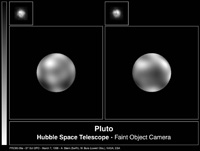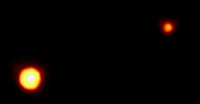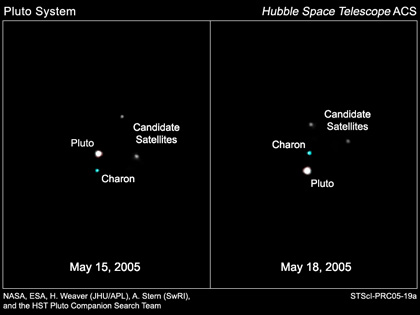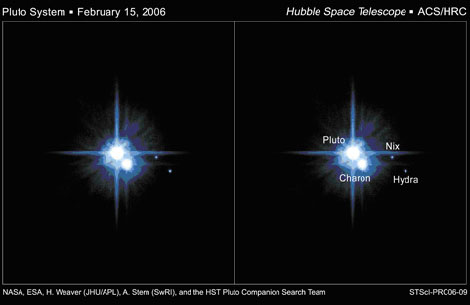On August 24, 2006 the IAU stripped Pluto of its status as a planet - instead it is now classified as a "dwarf planet." Read about the details on my Blog.
The
Applied Physics Laboratory (one of the lead
investigators of the
New Horizons
project) announced the official names of Pluto's
second and third moon: Nix and Hydra. This means
Pluto now has three moons. More details
below.
Clyde W. Tombaugh, staff member at the Lowell
Observatory, discovered Pluto on February 18, 1930.
The process was painful, the result of "blinking"
where two photographic plates are compared against
each other to look for any changes in object
appearance and position.
Our knowledge of Pluto
comes as a result of
mathematic and
spectroscopy. We
know that Pluto is composed of the same rock-ice
material as the moons of
Uranus and
Neptune. It is
likely that Pluto's surface contains a combination
of carbon dioxide ice, methane ice, and nitrogen
ice.
Pluto - A Quick Summary: (More information available on the Pluto Fact Sheet)
 |
Average Distance from Sun: |
5.915 x 109 km |
| Eccentricity of Orbit: |
0.2501 |
| Average Orbital Speed: |
4.7 km/s |
| Orbital Period: |
248.60 years |
| Rotational Period: |
6.387 days |
| Inclination of Equator to
Orbit |
122.52º |
| Diameter: |
2,300 km |
| Mass: |
1.3 x 1022 kg |
 |
Average Density: |
1900 kg/m3 |
| Escape Speed: |
1.2 km/s |
| Albedo: |
0.5 |
 |
| Average Surface
Temperature: |
-233º
C |
| Atmospheric
Composition: |
None |
Back to Top Pluto may have two additional
moons, which could make 3 moons for Pluto.
Observations using the Hubble Space Telescope in May
of 2005 demonstrated two candidates.

More details can be found at the
Hubble Space Telescope website. What is surprising about Pluto
is that it has a moon - sort of. The moon of Pluto -
called Charon - was discovered in 1978. The
composition of Charon is thought to be identical to
Pluto. The current idea is that Charon is not a
moon, but a member of the Pluto-Charon system (a
binary planet). Charon does not
orbit Pluto and
Pluto does not
orbit Charon. Instead, the both
rotate about a common point. There is also debate
as to the planet classification of Pluto:
- Composition of Pluto and Charon is though to
be identical to the
Kuiper Belt Objects
- The inclination of Pluto's
orbit is 17º
, a secondary signature of a captured body
- Pluto's
orbit brings the planet closer to
the
Sun than
Neptune on during it annual
orbit
These issues will hopefully be answered when
the
New Horizons probe arrives at Pluto.
Nix and Hydra:
The discovery team responsible for the
New Horizons
project also discovered (its official now) the two
additional satellites in May of 2005. What is more
remarkable is the tool used to discover the moons:
the Hubble Space Telescope. The two new moons are
5000 times more faint than Pluto and two to three
times the Pluto-Charon distance.

The team initially names the moons Nyx S/2005 P2 and
Hydra S/2005 P1. Nyx was renamed to Nix by the
IAU
since asteroid 3908 bears the name Nyx (the name of
the Greek goddess of darkness and night). Nix is the
Egyptian equivalent to Nyx. Hydra is the
mythological sea serpent with nine heads.
A bit of trivia: the first two
letters of Pluto (P and L) is used to honor Percival
Lowell who motivated the search for Pluto. In
addition, the first letters of Nix and Hydra are
used to honor the New Horizons mission and the
Hubble Space Telescope (the letters N and H).
Hydra is the brighter (possibly larger) outer moon
while Nix is the dimmer (possibly smaller)
middle moon (Charon is closest to Pluto and the
brightest moon). The orbit's of Nix and Hydra are
near circular and are on the same plane as Charon -
but at greater distance. This demonstrates a
possible common origin of Charon, Nix and Hydra -
the result of a large impact of some object with
Pluto. Astronomers will point their
telescopes toward these two new moons in order to
learn their properties. In addition, the arrival of
New Horizons in 2015 will provide detailed mapping.
Back to Top |

